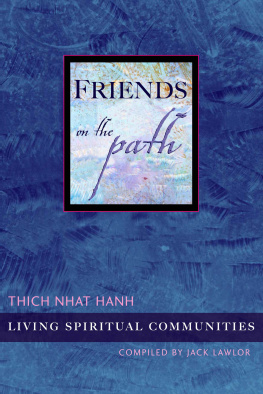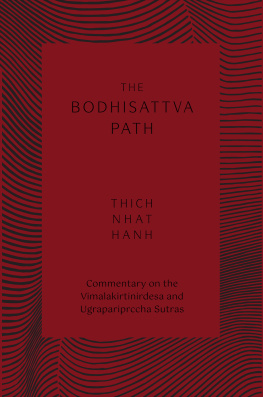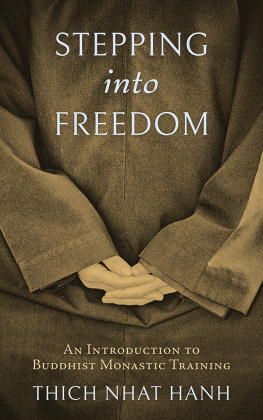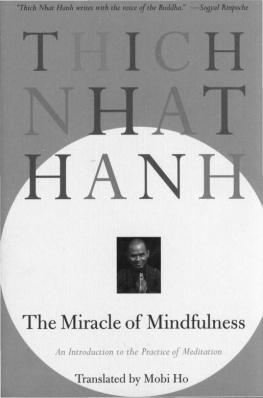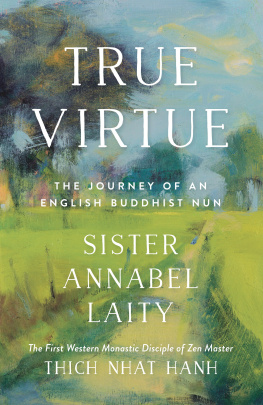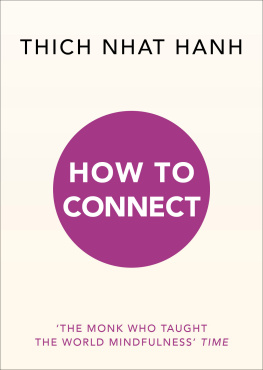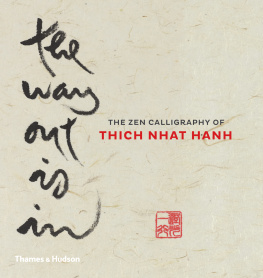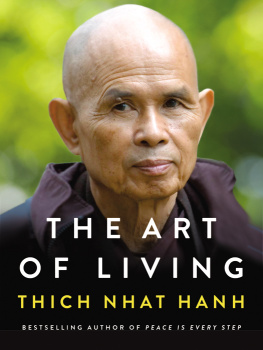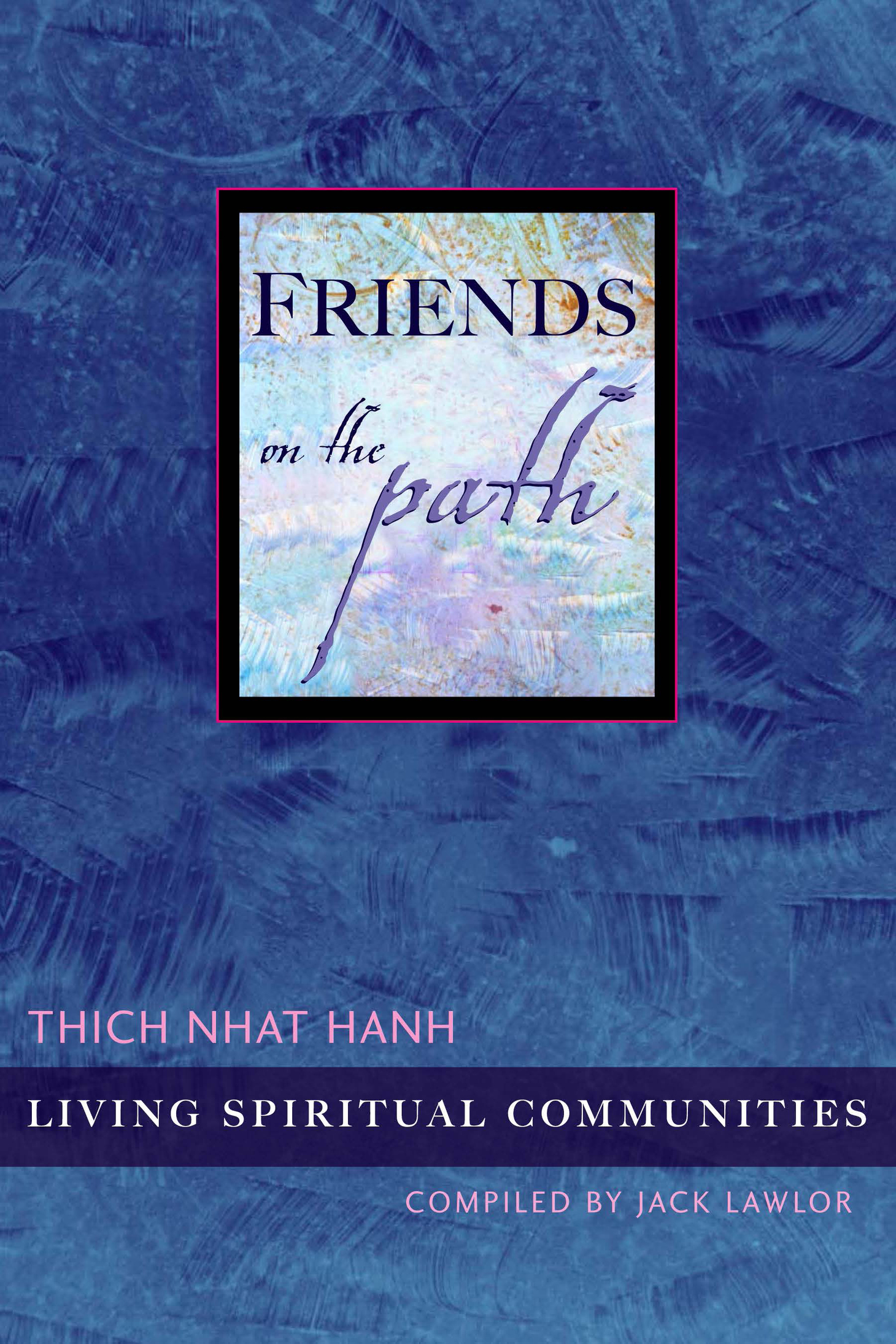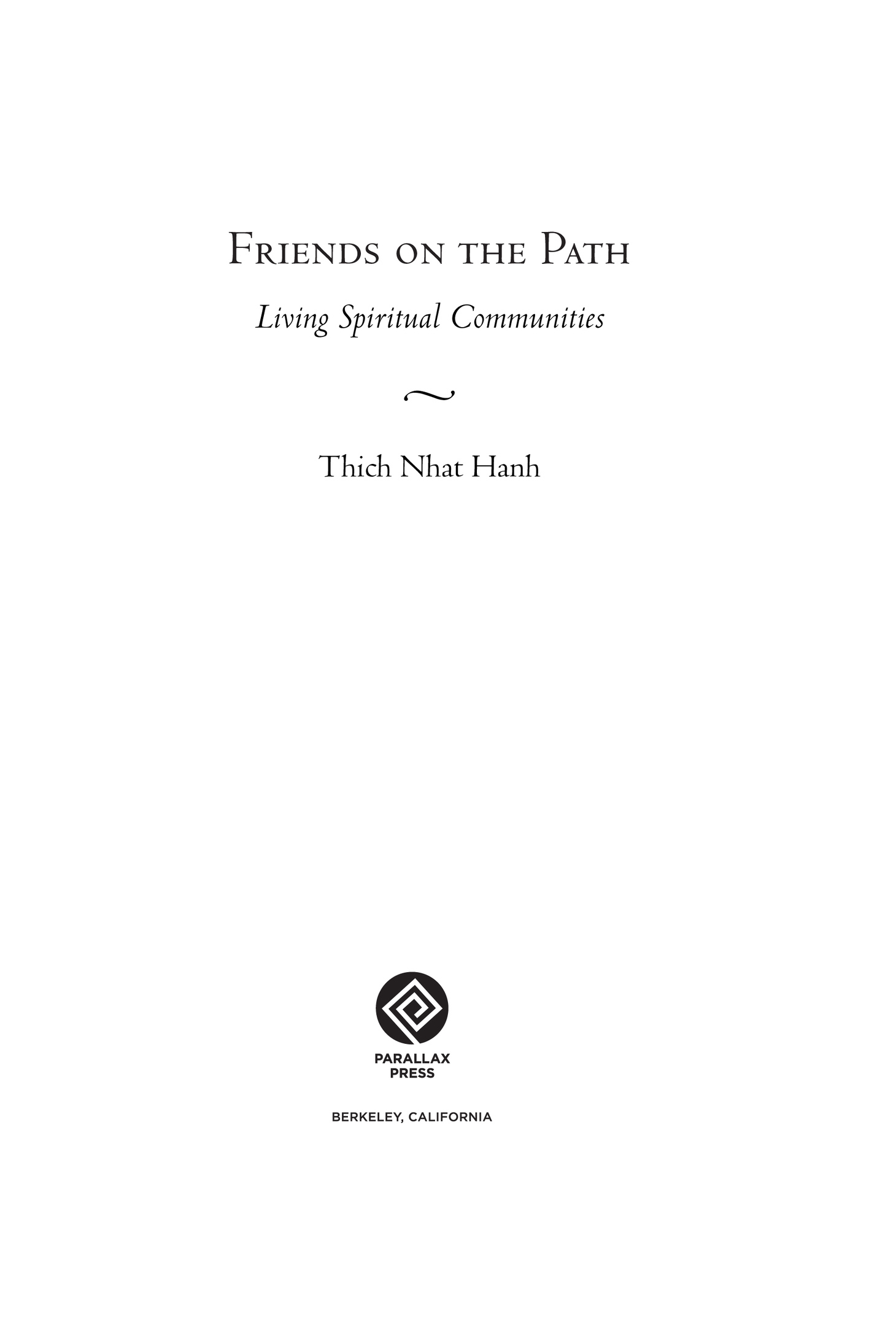P.O. Box 7355
Parallax Press is the publishing division of Plum Village Community of Engaged Buddhism, Inc.
2002 Plum Village Community of Engaged Buddhism, Inc.
All Rights Reserved.
Compiled by Jack Lawlor.
Ebook design adapted from printed book designed by Gopa & Ted2.
Friends on the path : living spiritual communities / edited by Jack Lawlor; with contributions from Thich Nhat Hanh and others.
p. cm.
1. Buddhist sanghas. 2. Monasticism and religious orders, Buddhist. 3. BuddhismSocial aspects. I. Lawlor, Jack, 1951- II. Nhat Hanh, Thich.
Introduction
BY JACK LAWLOR
T HERE IS A PATH along the wes tern boundary of the Upper Hamlet in Plum Village. Because it runs along a ridge, one can enjoy very beautiful sunsets that cast long shadows into the bucolic valley below. It is all part of the gently undulating landscape of the Bordeaux region in southwestern France.
Everyone who passes the trailhead is attracted to take the journey. The limbs of a long line of mature trees on either side of the dirt trail meet together as if in prayer to form a chapel-like arch overhead. As one approaches, a simple wooden sign welcomes you from the side of a tree. It offers a very importantbut often forgottensuggestion from the Buddha: Go as a Sangha.
In essence, this sign is inviting us to enjoy the path together as companions and spiritual friends (in the Sanskrit language, kalyanamitra). A Sangha is a group of people who practice mindfulness together, inspired by the historic Buddha, his teachings (the Dharma), and the presence of other mindfulness practitioners (the Sangha itself). Mindfulness is the fluid, gentle awareness and clear perception that arise within us naturally, with grace and ease, when we engage in simple meditative exercises based on conscious breathing. Venerable Thich Nhat Hanh (also known simply as Thy) has described conscious breathing as the miracle of mindfulness that mends the dispersion between what the body is doing, on the one hand, and what the mind is doing, on the other. It enables us to dwell fully in the present and to enjoy the people were with. Those who learn to practice mindfulness experience shamatha, the stopping of habit energy; appamada, freedom from agitation and madness; and praja, insight and understanding into what is actually going on, so that karuna, compassion, may arise. Its a simple, refreshing way to live. And nearly everyone finds that its easiest to do in the company of friends.
The Buddha spent most of his life in the company of a Sangha, and for 2,500 years the Sangha has been considered one of the Three Jewelstogether with the Buddha and Dharma. Whenever a Sangha convenes, it does so in the spirit of friends on the path.
Although for twenty-five centuries Buddhists have been taught to have faith in the Sangha, Thich Nhat Hanh has brought this teaching to life by demonstrating how taking refuge in the Sangha as friends on the path is a practice, not just a matter of faith or a declaration of loyalty. If the Buddha took care to find nourishment in this practice, we might explore the benefits of doing the same. Based on the teachings of Thich Nhat Hanh and experiences of mindfulness practitioners from around the world, this is what Friends on the Path invites us to do.
Part One, Living Spiritual Communities, contains Thys most recent teachings on Sangha. These insightful and inspirational pieces demonstrate the importance of Sangha in the world today. They also show how our practice deepens and grows when we learn from each other as spiritual friends rather than alone in the company of books and tapes.
During the 1980s, Thy traveled throughout the world urging students of meditation that, based upon the practice of conscious breathing, we must practice in a way that removes the barrier between practice [in the meditation hall] and non-practice. Inspired by this message of engaged Buddhism, practitioners have done just that. In the past fifteen years, over 350 nonresidential lay Sanghas have emerged in over twenty countries throughout the world, together with several lay residential communities and three monastic centers. From their experiences there is a lot to share about how kalyanamitra can give birth to a healthy Sangha in our own local communities, and how we can nourish our Sanghas so that they mature into something alive, flexible, inclusive, tolerant, supportive, and vibrant.
The insights in this book are not offered from an academic or theoretical point of view about what has been or might become part of the Buddhist tradition. In every casewhether describing monastic practice, lay residential or nonresidential practice, or nonsectarian mindfulness practice centersthe contributions are offered by seasoned spiritual friends who are reporting on what they have learned from their experience. There is much that we can learn from the collective wisdom of the group.
In Part Two, Gathering Good Friends, I offer an overview of lay Sangha practice. This section describes what it feels like to extend the joy and equanimity experienced during residential retreats right into the heart of your hometown and into your daily life by building a living spiritual community. After describing how local Sanghas enjoy a typical evening together, the overview explores frequently asked questions about the various skillful ways first to organize a lay Sangha and then to nourish and sustain it with a complementary spectrum of mindfulness practicesall with a light touch, and all in the spirit of friendship and caring.
Part Three, Residential Practice, includes contributions from monastics (including Sister Annabel Laity, Abbess of Green Mountain Dharma Center) and lay Dharma teachers at practice within residential communities. Part Four, Sangha-Building, includes insightful essays on starting a Sangha or Mindfulness Practice Center. Part Five, Sangha Practice, looks deeply at residential and nonresidential Sangha practice. Part Six takes a look at Practicing with Young People. Part Seven, Engaged Practice, touches on the mindfulness practice of loving kindness and non-fear as spiritual friends encounter and meet the challenges of illness and death within their own Sangha and in the practice of building a Sangha in prison.
Part Eight, A Taste of Community Life, provides a sampling of Sangha life from contributors around the world. The Buddha spent his forty-five-year teaching career interacting with the many tribes and small kingdoms in northern India and listening to people from every level of society during his daily almsrounds with the monastic Sangha. The practices we now refer to as Buddhism are the result of this interaction, which continues throughout the world to this day, with Buddhism encountering and interpenetrating the West and the West interpenetrating Buddhism. The offerings in Part Four illustrate this vibrant spiritual growth and diversification.
What do these articles suggest about the ability of spiritual friends to practice together in our own times? As you might suspect, Buddhism and mindfulness practice in the West have changed immensely in the last thirty years. Beginning in 1974, my wife, Laurie, and I have practiced consistently with organized Zen meditation groups in both the Japanese and Vietnamese traditions. Since then, books on Buddhism and mindfulness practice have moved from alongside the occult and astrology books in bookstores and libraries to the mainstream displays. This has brought with it both advantages and disadvantages. On the one hand, mindfulness practice now has the potential to influence and transform certain habit energies in our society (such as materialism, militarism, and intolerance) with insight, equanimity, and compassion that are the fruits of sustained and wholehearted practice. On the other hand, some of the more challenging aspects of the Buddhas teachingssuch as deep listening and insight, taking responsibility to change destructive personal habit patterns in order to transform suffering at its root, and the ability to live compassionately as a true friend of othersstand the risk of becoming diluted.

